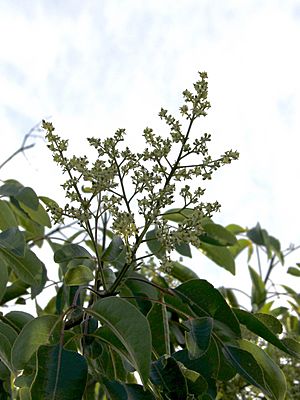Noyer facts for kids
Quick facts for kids Noyer |
|
|---|---|
 |
|
| Conservation status | |
| Scientific classification | |
| Genus: |
Zanthoxylum
|
| Species: |
flavum
|
Zanthoxylum flavum is a medium-sized tree that belongs to the plant family Rutaceae. It has several common names, including noyer, West Indian satinwood, yellow sanders, tembetaria, and yellow sandalwood.
This tree naturally grows in many places across the Caribbean and nearby areas. You can find it in Anguilla, Antigua and Barbuda, the Bahamas, Bermuda, Cuba, the Dominican Republic, Guadeloupe, Haiti, Jamaica, Puerto Rico, and the Florida Keys. However, it no longer grows in Key West, where it has disappeared from the wild.
Sadly, Zanthoxylum flavum is a threatened species. Its numbers are decreasing because its natural home is being destroyed. Also, people harvest its wood, which is very strong and used for making beautiful furniture and other fine wooden items.
Where the Satinwood Tree Grows
The Zanthoxylum flavum tree lives in warm, sunny places called subtropical regions. These areas often get a lot of rain all year, or they might have clear wet and dry seasons.
This tree can grow in many different types of soil. It does well in soils that drain water quickly, like those made from old volcanoes. It also thrives in clay soils that hold water well but still drain properly. Interestingly, it can even grow in special soils called serpentine soils, which are unusual for many plants.
What the Satinwood Tree Looks Like
The Zanthoxylum flavum tree usually grows with a straight trunk, which is called a bole. At the top, it has a small crown of leaves. Its leaves are pinnately compound, meaning they have many leaflets arranged along a central stem, like a feather.
The tree produces clusters of small flowers that are pale yellow to cream-colored. The name flavum comes from Latin and means "yellow," which describes its flower color. After the flowers, the tree grows small black seeds.
Bees likely help to pollinate the flowers, which means they help the plant make seeds. The seeds are probably spread around by birds and bats. These animals eat the seeds and then drop them in new places, helping the tree to grow in new areas. This is similar to how seeds are spread for a related tree called Z. martinicense.
See also
 In Spanish: Zanthoxylum flavum para niños
In Spanish: Zanthoxylum flavum para niños


